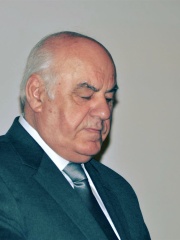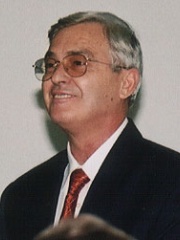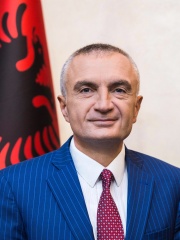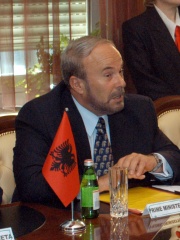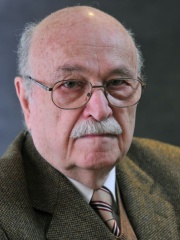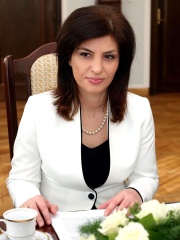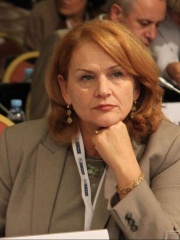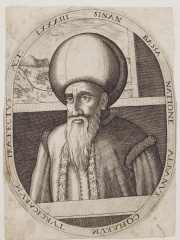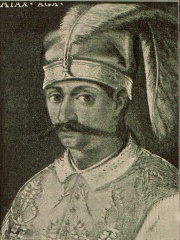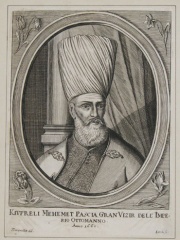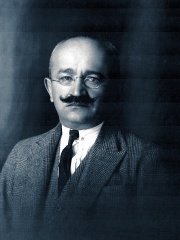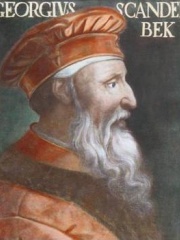
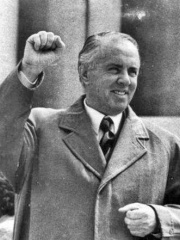
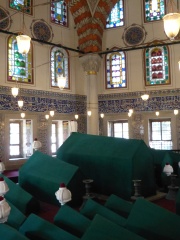
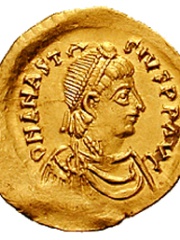
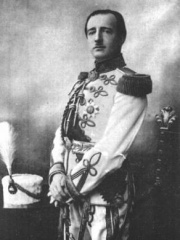
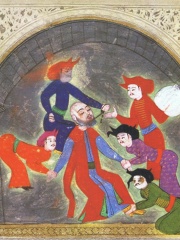

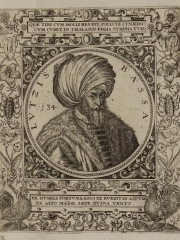
The Most Famous
POLITICIANS from Albania
This page contains a list of the greatest Albanian Politicians. The pantheon dataset contains 15,577 Politicians, 42 of which were born in Albania. This makes Albania the birth place of the 66th most number of Politicians behind Lebanon and Philippines.
Top 10
The following people are considered by Pantheon to be the top 10 most legendary Albanian Politicians of all time. This list of famous Albanian Politicians is sorted by HPI (Historical Popularity Index), a metric that aggregates information on a biography’s online popularity. Visit the rankings page to view the entire list of Albanian Politicians.

1. Skanderbeg (1405 - 1468)
With an HPI of 78.55, Skanderbeg is the most famous Albanian Politician. His biography has been translated into 70 different languages on wikipedia.
Gjergj Kastrioti (c. 1405 – 17 January 1468), commonly known as Skanderbeg, was an Albanian feudal lord and military commander who led a rebellion against the Ottoman Empire in what is today Albania, North Macedonia, Greece, Kosovo, Montenegro, and Serbia. A member of the noble Kastrioti family, he was sent as a hostage to the Ottoman court. He graduated from the Enderun School and entered the service of the Ottoman sultan Murad II (r. 1421–1444) for the next twenty years. His rise through the ranks culminated in his appointment as sanjakbey of the Sanjak of Dibra in 1440. During the Battle of Nish in 1443, he deserted the Ottomans and became the ruler of Krujë and nearby areas extending from Petrelë to Modrič. In March 1444, he established the League of Lezhë, with support from local noblemen, and unified the small Albanian principalities. In 1451, through the Treaty of Gaeta, he recognized de jure the sovereignty of the Kingdom of Naples over Albania, ensuring a protective alliance, although he remained a de facto independent ruler. In 1460–61, he supported Ferdinand I of Naples (r. 1458–1494) in his wars and led an Italian expedition against John II of Anjou (r. 1453–1470). In 1463, he was earmarked to be the chief commander of the crusading forces of Pope Pius II, but the Pope died while the armies were still gathering and the greater European crusade never took place. Together with Venetians, he fought against the Ottomans during the First Ottoman–Venetian War (1463–1479) until his death. Skanderbeg ranks high in the military history of that time as the most persistent—and ever-victorious—opponent of the Ottoman Empire during its heyday. He became a central figure in the Albanian National Awakening of the 19th century. He is honoured in modern Albania, and is commemorated with many monuments and cultural works. Skanderbeg's military skills presented a major obstacle to Ottoman expansion, and many in western Europe considered him to be a model of Christian resistance against Muslims.

2. Enver Hoxha (1908 - 1985)
With an HPI of 77.13, Enver Hoxha is the 2nd most famous Albanian Politician. His biography has been translated into 80 different languages.
Enver Hoxha (Albanian: [ɛnˈvɛɾ ˈhɔdʒa] ; 16 October 1908 – 11 April 1985) was an Albanian politician who was the ruler of Albania from 1944 until his death in 1985. He was the First Secretary of the Party of Labour of Albania from 1941 until his death, a member of its Politburo, chairman of the Democratic Front of Albania, and commander-in-chief of the Albanian People's Army. He was the twenty-second prime minister of Albania from 1944 to 1954 and at various times was both foreign minister and defence minister of the country. Hoxha was born in Gjirokastër in 1908 and became a grammar school teacher in 1936. Following the Italian invasion of Albania, he joined the Party of Labour of Albania at its creation in 1941 in the Soviet Union. He was elected First Secretary in March 1943 at the age of 34. Less than two years after the liberation of the country, the monarchy of King Zog I was formally abolished, and Hoxha became the country's de facto head of state. Adopting Stalinism, Hoxha converted Albania into a one-party communist state. As a Stalinist, he implemented state atheism and ordered anti-religious persecution against Muslims and Christians. His government rebuilt the country, which was left in ruins after World War II, building Albania's first railway line, raising the adult literacy rate from 5–15% to more than 90%, wiping out epidemics, electrifying the country and leading Albania towards agricultural independence. The later years of his reign saw stagnation owing to his political breaks with the Soviet Union and China. To implement his radical program, Hoxha used totalitarian methods of governance. His government outlawed traveling abroad and private proprietorship. His government imprisoned, executed, or exiled thousands of landowners, rural clan leaders, peasants who resisted collectivization, and allegedly disloyal party officials. Hoxha was succeeded by Ramiz Alia, who oversaw the fall of communism in Albania. Hoxha's government was characterised by his proclaimed firm adherence to anti-revisionist Marxism–Leninism from the mid/late-1960s onwards. After his break with Maoism in the 1976–1978 period, numerous Maoist parties around the world declared themselves Hoxhaist. The International Conference of Marxist–Leninist Parties and Organisations (Unity & Struggle) is the best-known association of these parties.

3. Safiye Sultan (1550 - 1619)
With an HPI of 76.95, Safiye Sultan is the 3rd most famous Albanian Politician. Her biography has been translated into 35 different languages.
Safiye Sultan (Ottoman Turkish: صفیه سلطان; "the pure one" c. 1550 — after 1619) was the Haseki Sultan of Murad III and Valide Sultan of the Ottoman Empire as the mother of Mehmed III and the grandmother of Sultans Ahmed I and Mustafa I. Safiye was also one of the eminent figures during the era known as the Sultanate of Women. She lived in the Ottoman Empire as a courtier during the reigns of seven sultans: Suleiman the Magnificent, Selim II, Murad III, Mehmed III, Ahmed I, Mustafa I and Osman II. After the death of Selim II in 1574, Murad took the throne as the new sultan in Constantinople. Safiye was by his side and moved with him to Topkapi Palace; less than a year into his reign she received the title of Haseki Sultan and was given a higher rank than the sultan's own sisters, Şah Sultan, Gevherhan Sultan, Ismihan Sultan and Fatma Sultan. Nurbanu Sultan, Murad's mother, was upset with Safiye's influence on Murad, and wanted to replace her with another concubines of the harem. She even led a faction in the court from 1577 to 1580 in opposition to her mother-in-law and the her faction. The struggle of these two women to influence the Sultan's life, his decisions and the government groups increased in 1579, as the death of the powerful Grand Vizier Sokollu Mehmed Pasha along with the isolation of the Sultan, opened the door to the exercise of power for anyone who was close to the Sultan. The conflict between Safiye and Nurbanu reached a crisis point in 1580, and Murad sent Safiye to Eski Saray. She lived there for some years before Nurbanu's death, but Murad brought her back to him sometime after his mother's death in December 1583. Without Nurbanu, she became the most powerful woman in the harem. Moreover, she was not contented with her position, and began to intervene in state affairs, ultimately to become one of the most powerful figures of Murad's reign, and she directed her union network on a larger scale to once again influence state affairs. She strengthened her position in the court when she became the Valide Sultan upon the ascension of her son Mehmed III in 1595, after Murad's death. As Valide Sultan, her personal purse was three times that of the Sultan, the highest level of salary for a person in the empire. During her son's reign, Mehmed consulted her on important matters and did not make a decision if it was not with her consent. People and civil servants directly appealed to her when they needed help, since they knew how influential she was within the Ottoman court; sometimes they would even throw themselves in front of her carriage for help. She was the most influential in directing everything related to the empire and the terms of appointments and dismissals of everyone in the Empire, even the Grand Vizier and Shaykh al-Islam. When Mehmed III went on the campaign of Eger in 1596, he left a treasure of one billion akçe to her service, and he gave her the power to audit important matters in his absence. She distributed alms to the poor, orphans, and widows upon the fall of Eger Castle. Safiye Sultan did not only interfere in interior affairs but also in foreign affairs of the empire. It is known that she corresponded by letters with foreign kings and queens and established diplomatic relations with them. Like her mother-in-law Nurbanu, she supported a pro-Venetian policy in foreign politics. But in the last years of her son's reign, her meddling in state affairs caused three destructive rebellions and made her immensely disliked by the soldiers and the people: However, until the end of her son's reign, no one could break her dominance and influence over his government. But even for a short period of several weeks in 1600, even the Sultan saw his mother's influence on him and her presence in the palace as disturbing and insisted that she leave the palace and no longer control his affairs. However, she had built extensive support network, and continued to exert a tacit influence over the state through one of the chief eunuchs, appointing her allies to powerful positions. After 5 weeks, the Sultan canceled his mother's exile and brought her back to his palace and placed her in the inner circle of advisors, who actually ran the government. Upon the death of Mehmed III in 1603, she was sent to Eski Saray on January 9, 1604, and lived there in retirement without political influence or returning to the court until her death. She was laid to rest in the tomb of Murad III.

4. Anastasius I Dicorus (430 - 518)
With an HPI of 70.05, Anastasius I Dicorus is the 4th most famous Albanian Politician. His biography has been translated into 55 different languages.
Anastasius I Dicorus (Greek: Ἀναστάσιος, translit. Anastásios; c. 431 – 9 July 518) was Eastern Roman emperor from 491 to 518. A career civil servant, he came to the throne at the age of 61 after being chosen by the wife of his predecessor, Zeno. His reign was characterised by reforms and improvements in the empire's government, finances, economy and bureaucracy. He is noted for leaving the empire with a stable government, reinvigorated monetary economy and a sizeable budget surplus, which allowed the empire to pursue more ambitious policies under his successors, most notably Justinian I. Since many of Anastasius' reforms proved long-lasting, his influence over the empire endured for many centuries. Anastasius was a Monophysite Christian and his personal religious tendencies caused tensions throughout his reign in the empire that was becoming increasingly divided along religious lines. He is venerated as a saint by the Syriac Orthodox Church on 29 July.
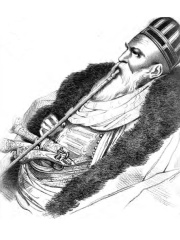
5. Ali Pasha of Ioannina (1750 - 1822)
With an HPI of 69.78, Ali Pasha of Ioannina is the 5th most famous Albanian Politician. His biography has been translated into 37 different languages.
Ali Pasha, or Ali Pasha of Tepelena (Albanian: Ali Tepelena; 1740 – January 24, 1822), commonly known as Ali Pasha of Ioannina, was an Albanian ruler who served as Ottoman pasha of the Pashalik of Yanina, a large part of western Rumelia. Under his rule, it acquired a high degree of autonomy and even managed to stay de facto independent. The capital of the Pashalik was Ioannina, which, along with Tepelena, was Ali's headquarters. Conceiving his territory in increasingly independent terms, Ali Pasha's correspondence and foreign Western correspondence frequently refer to the territories under Ali's control as "Albania." This, by Ali's definition, included central and southern Albania, and parts of mainland Greece; in particular, most of the district of Epirus and the western parts of Thessaly and Macedonia. He managed to stretch his control over the sanjaks of Yanina, Delvina, Vlora and Berat, Elbasan, Ohrid and Monastir, Görice, and Tirhala. Ali was granted the Sanjak of Tirhala in 1787, and he delegated its government in 1788 to his second-born Veli Pasha, who also became Pasha of the Morea Eyalet in 1807. Ali's eldest son, Muhtar Pasha, was granted the Sanjak of Karli-Eli and the Sanjak of Eğriboz in 1792, stretching for the first time Ali's control down to Livadia and the Gulf of Corinth, except Attica. Muhtar Pasha also became governor of the Sanjak of Ohrid in 1796–7 and of the Sanjak of Vlora and Berat in 1810. Ali first appears in historical accounts as the leader of a band of Albanian brigands who became involved in many confrontations with Ottoman state officials in Albania and Epirus. He joined the administrative-military apparatus of the Ottoman Empire, holding various posts until 1788, when he was appointed pasha, ruler of the Sanjak of Ioannina. His diplomatic and administrative skills, his interest in modernist ideas and concepts, his popular Muslim piety, his respect towards other religions, his suppression of banditry, his vengefulness and harshness in imposing law and order, and his looting practices towards persons and communities in order to increase his profits caused both the admiration and the criticism of his contemporaries, as well as an ongoing controversy among historians regarding his personality. As his influence grew, his involvement in Ottoman politics increased culminating in his active opposition to the ongoing Ottoman military reforms. After being declared a rebel in 1820, he was captured and killed in 1822 at the age of 81 or 82, after a successful military campaign against his forces. In Western literature, Ali Pasha became the personification of an "oriental despot."

6. Zog I of Albania (1895 - 1961)
With an HPI of 68.48, Zog I of Albania is the 6th most famous Albanian Politician. His biography has been translated into 60 different languages.
Zog I (Ahmed Muhtar Zogolli; 8 October 1895 – 9 April 1961) was the leader of Albania from 1922 to 1939. At age 27, he first served as Albania's youngest ever Prime Minister (1922–1924), then as president (1925–1928), and finally as king (1928–1939). Born to a beylik family in Ottoman Albania, Zog was active in Albanian politics from a young age and fought on the side of Austria-Hungary during the First World War. In 1922, he adopted the name Ahmed Zogu. He held various ministerial posts in the Albanian government before being driven into exile in June 1924, but returned later in the year with Yugoslav and White Russian military support and was subsequently elected prime minister. Zog was elected president in January 1925 and vested with dictatorial powers, with which he enacted major domestic reforms, suppressed civil liberties, and struck an alliance with Benito Mussolini's Italy. In September 1928, Albania was proclaimed a monarchy and he acceded to the throne as Zog I, King of the Albanians. He married Geraldine Apponyi de Nagy-Appony in 1938, and their only child Leka was born a year later. Albania fell further under Italian influence during Zog's reign, and by the end of the 1930s the country had become almost fully dependent on Italy despite Zog's resistance. In April 1939, Italy invaded Albania and the country was rapidly overrun. Mussolini declared Albania an Italian protectorate under King Victor Emmanuel III, forcing Zog into exile. He lived in England during the Second World War but was barred from returning to Albania by Enver Hoxha's communist regime. Zog spent the rest of his life in France and died in April 1961 at the age of 65. His remains were buried at the Thiais Cemetery near Paris, before being transferred to the royal mausoleum in Tirana in 2012.

7. Kara Ahmed Pasha (1450 - 1555)
With an HPI of 67.83, Kara Ahmed Pasha is the 7th most famous Albanian Politician. His biography has been translated into 27 different languages.
Kara Ahmed Pasha (executed 29 September 1555) was an Ottoman statesman of Albanian origin. He was Grand Vizier of the Ottoman Empire between 1553 and 1555. He led the Ottoman troops that captured the Hungarian fortress of Temesvár, defended by the troop of István Losonczy, on 26 July 1552. That year, his army took three other castles (Veszprém, Szolnok and Lipova) before failing at the siege of Eger. After Sultan Suleiman executed his eldest son Şehzade Mustafa in October 1553, there appeared some sort of dissatisfaction and unrest among soldiers who blamed Rüstem Pasha for Mustafa's death. Then Suleiman dismissed Rüstem Pasha and appointed Kara Ahmed Pasha as his Grand Vizier in October 1553. But almost two years later, Kara Ahmed was strangled by Suleiman's order in September 1555. It is said that the reason for the execution was due to political manoeuvrings of Suleiman's legal wife Hürrem Sultan, who wanted her son-in-law Rüstem to become the Grand Vizier again. After the death of Kara Ahmed, Rüstem Pasha became the Grand Vizier (1555–1561) once more.

8. Ramiz Alia (1924 - 2011)
With an HPI of 66.66, Ramiz Alia is the 8th most famous Albanian Politician. His biography has been translated into 49 different languages.
Ramiz Alia (Albanian pronunciation: [ɾaˈmiz aˈlia] ; 18 October 1925 – 7 October 2011) was an Albanian politician serving as the second and last leader of the People's Socialist Republic of Albania from 1985 to 1991, serving as First Secretary of the Party of Labour of Albania. He was also the country's head of state from 1982 to 1992. He had been seen as a successor by Enver Hoxha and took power after Hoxha died.

9. Lütfi Pasha (1488 - 1562)
With an HPI of 65.46, Lütfi Pasha is the 9th most famous Albanian Politician. His biography has been translated into 24 different languages.
Lütfi Pasha (Ottoman Turkish: لطفى پاشا, Luṭfī Paşa; Modern Turkish: Lütfi Paşa, more fully Damat Çelebi Lütfi Paşa; c. 1488 – 27 March 1564, Didymoteicho) was an Ottoman Albanian statesman, general, and Grand Vizier of the Ottoman Empire under Suleiman the Magnificent from 1539 to 1541. He wrote 21 works mainly on religious topics but also on history, 13 of them written in Arabic and eight in Turkish. Two of his works are the Asafname, a kind of mirror for ministers, and the Tevâriḫ-i Âl-i ‘Os̱mân, dealing with Ottoman history and including his own experiences in the reign of the sultans Bayezid II, Selim I and Suleyman I. In the TV series Muhteşem Yüzyıl, Lütfi Pasha is played by Turkish actor Mehmet Özgür.

10. Sali Berisha (1944 - )
With an HPI of 65.04, Sali Berisha is the 10th most famous Albanian Politician. His biography has been translated into 61 different languages.
Sali Ram Berisha (Albanian: [saˈli bɛˈɾiʃa] ; born 15 October 1944) is an Albanian cardiologist and conservative politician who served as the president of Albania from 1992 to 1997 and 32nd prime minister from 2005 to 2013. Berisha serves as Chairman of the Democratic Party of Albania since 2022 and has held the position previously from 1990 to 2013. He also serves as the incumbent Leader of Opposition in the Albanian parliament. He has been banned from entering the United States and the United Kingdom after being accused of "involvement in significant corruption" and links to organised crime groups and criminals that pose a "risk to public safety in Albania". On 9 September 2021, Berisha was expelled by party chairman Lulzim Basha from the Democratic Party's Parliamentary Group due to legal issues with the US Department of State. This decision led to put 79-year-old Berisha starting a nation-wide movement to remove Basha as leader of the Democratic Party, causing a major rift in the party's internal structures, between Berisha's and Basha's supporters. On 30 December 2023, Berisha was placed under house arrest for allegations regarding corruption in his previous governments.
Pantheon has 42 people classified as politicians born between 300 BC and 1977. Of these 42, 16 (38.10%) of them are still alive today. The most famous living politicians include Sali Berisha, Alfred Moisiu, and Edi Rama. The most famous deceased politicians include Skanderbeg, Enver Hoxha, and Safiye Sultan. As of April 2022, 4 new politicians have been added to Pantheon including Koca Davud Pasha, Xhafer Ypi, and Monika Kryemadhi.
Living Politicians
Go to all Rankings
Sali Berisha
1944 - Present
HPI: 65.04
Alfred Moisiu
1929 - Present
HPI: 61.19
Edi Rama
1964 - Present
HPI: 59.66
Rexhep Meidani
1944 - Present
HPI: 58.20
Bamir Topi
1957 - Present
HPI: 56.44
Ilir Meta
1969 - Present
HPI: 55.17
Fatos Nano
1952 - Present
HPI: 54.28
Aleksandër Meksi
1939 - Present
HPI: 48.30
Ylli Bufi
1948 - Present
HPI: 44.87
Jozefina Topalli
1963 - Present
HPI: 42.43
Arta Dade
1953 - Present
HPI: 42.21
Pandeli Majko
1967 - Present
HPI: 40.88

Deceased Politicians
Go to all Rankings
Skanderbeg
1405 - 1468
HPI: 78.55
Enver Hoxha
1908 - 1985
HPI: 77.13
Safiye Sultan
1550 - 1619
HPI: 76.95
Anastasius I Dicorus
430 - 518
HPI: 70.05
Ali Pasha of Ioannina
1750 - 1822
HPI: 69.78
Zog I of Albania
1895 - 1961
HPI: 68.48
Kara Ahmed Pasha
1450 - 1555
HPI: 67.83
Ramiz Alia
1924 - 2011
HPI: 66.66
Lütfi Pasha
1488 - 1562
HPI: 65.46
Koca Sinan Pasha
1520 - 1596
HPI: 63.42
Ayas Mehmed Pasha
1483 - 1539
HPI: 63.11
Köprülü Mehmed Pasha
1580 - 1661
HPI: 63.04

Newly Added Politicians (2022)
Go to all Rankings
Koca Davud Pasha
1401 - 1498
HPI: 53.43
Xhafer Ypi
1880 - 1940
HPI: 42.99
Monika Kryemadhi
1974 - Present
HPI: 32.18
Ditmir Bushati
1977 - Present
HPI: 28.52

Which Politicians were alive at the same time? This visualization shows the lifespans of the 15 most globally memorable Politicians since 1700.

